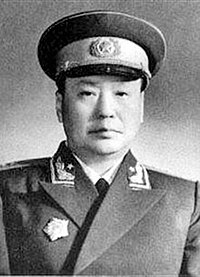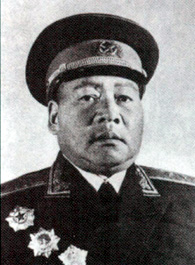Cleanup of Inner Mongolia

The so-called “cleansing” of Inner Mongolia ( Chinese 內人 黨 事件 / 内人 党 事件 ) was a massive political cleansing carried out by the ruling Communist Party of China against members of the “Party of the People's Revolution of Inner Mongolia (内蒙古 人民 革命 党) ”Judged during the Cultural Revolution , during which tens of thousands of people from the Mongolian minority were murdered or mutilated.
The "purge" was supported by the Central Committee of the Chinese Communist Party and led by Teng Haiqing (滕海清), a lieutenant general (zhong jiang) of the People's Liberation Army . It took place from 1967–1969. Over a million people were referred to as members of the "Party of the People's Revolution", which had already dissolved.
According to the official indictment of the People's Republic of China's Supreme Prosecutor's Office in 1980 (" Boluan Fanzheng Period "), 346,000 people were arrested, 16,222 people were sentenced to death or directly killed, and over 81,000 were crippled for life during the cleansing of Inner Mongolia. On the other hand, researchers estimate the death toll at 20,000 to 100,000 while hundreds of thousands have been arrested and persecuted and over a million people were involved, most of whom were ethnic Mongols .
Historical background
Cleansing Ulanhu
After “ Outstanding Leader ” Mao Zedong launched the Cultural Revolution in May 1966 , Ulanhu (乌兰夫), then chairman of the Inner Mongolia Autonomous Region of China , was widely accused of being an “anti-party activist” and persecuted since July 1966. Ulanhu has been charged with five "crimes" including anti-Maoism , anti-socialism and separatism. On August 16, Ulanhu was removed from his positions and under house arrest in Beijing .
In May 1967, Teng was responsible for the "Inner Mongolia Military Region (内蒙古 军区)". In November 1967 Teng Haiqing (滕海清) was appointed director of the newly established "Revolutionary Committee of Inner Mongolia (内蒙古 革命 委员会)". With the support of Lin Biao , Jiang Qing and Kang Sheng , Teng launched a massive cleanup aimed at "digging up" the "poison of Ulanhu" in Inner Mongolia.
People's Revolution Party
During the "purge" the already dissolved "Party of the People's Revolution of Inner Mongolia (内蒙古 人民 革命 党)" is said to have reestablished itself and brought it to power since 1960. Ulanhu is said to be the leader of the revolutionary party. Hundreds of thousands of people were accused and persecuted of being members of the party and were separatists.
On the other hand, during the purge, the Mongolian language was banned from publications and the Mongols were accused of being "the sons and heirs of Genghis Khan ".
The massacre
The methods used in lynching and massacres during the purge included branding with hot irons, feeding oven waste, removing livers, hanging up, cutting tongues and noses, piercing nails, piercing Vagina, pouring hot salt water into wounds and much more.
- The official death toll (1980) was 16,222.
- According to Ba He (巴赫), approximately 100,000 people have been killed, 700,000–800,000 arrested and persecuted, and over a million have been affected.
- Chinese historian Song Yongyi (宋永毅) pointed out that, according to an unofficial source, the real death toll was at least 40,000, while around 140,000 people were crippled for life and nearly 700,000 persecuted.
- According to historian Lhamjab A. Borjigin (拉 幕 札 部), who was arrested and prosecuted by the Chinese government in 2019 for investigating the purge: At least 27,900 were killed and 346,000 were imprisoned and tortured.
Aftermath and rehabilitation
After the Cultural Revolution, Deng Xiaoping became China's new supreme leader in December 1978; He started the " Boluan Fanzheng " program to correct mistakes made in the Cultural Revolution.
After the Cultural Revolution, the purge was viewed as a so-called "mistake" and its victims were rehabilitated by the Chinese Communist Party (CPC). The Communist Party blamed Lin Biao and the " Gang of Four " for cleaning up Inner Mongolia.
However, the "Cleanse" commander, Teng Haiqing, received no trial or punishment because the CPC Central Committee believed it had achieved success in previous wars. Some of Teng's affiliates have received various sentences, with a major Mongolian (乌兰巴 干) member sentenced to 15 years in prison.
See also
Individual evidence
- ↑ a b c d e f g h i j k l 十年浩劫 中 的 内蒙古. In: Xinhuanet. Retrieved July 1, 2020 .
- ↑ a b c d e f g h i j k l m n Kerry Brown: The Cultural Revolution in Inner Mongolia 1967–1969: The Purge of the "Heirs of Genghis Khan" . In: Asian Affairs . 38, No. 2, July 1, 2007, ISSN 0306-8374 , pp. 173-187. doi : 10.1080 / 03068370701349128 .
- ↑ a b c d e f g Chronology of Mass Killings during the Chinese Cultural Revolution (1966-1976) | Sciences Po Mass Violence and Resistance - Research Network. In: www.sciencespo.fr. Retrieved December 5, 2019 .
- ↑ a b c d e f g h i j k Ba Yantai (巴彦 泰): 挖 肃 灾难 实录. In: Southern Mongolian Human Rights Information Center. September 1999, accessed June 30, 2020 .
- ^ "The Cultural Revolution in Inner Mongolia" by Paul Hyer and William Heaton. In: 内 モ ン ゴ ル と 中国 文化大革命. Retrieved December 5, 2019 .
- ↑ Kerry Brown: The Purge of the Inner Mongolian People's Party in the Chinese Cultural Revolution, 1967-69: A Function of Language, Power and Violence . Global Oriental, 2004, ISBN 978-1-901903-49-2 ( brill.com [accessed July 1, 2020]).
- ↑ Bai Yintai (白 音 太): “内人 党” 冤案 前后. In: Chinese University of Hong Kong. Retrieved July 1, 2020 .
- ↑ Inner Mongolia in 'War-Like State'. Retrieved July 1, 2020 .
- ↑ a b China Holds Ethnic Mongolian Historian Who Wrote 'Genocide' Book. In: Radio Free Asia. Retrieved December 5, 2019 .
- ↑ Jonathan Unger: Turmoil at the Grassroots in China's Cultural Revolution: A Half-Century Perspective. In: Made in China Journal. January 18, 2019, Retrieved December 5, 2019 (American English).
- ↑ a b c d e f Yang Jishen (杨继 绳): 天地 翻覆: 中国 文化大革命 历史 . 天地 图书, July 4, 2017 ( here in Google Book Search [accessed July 1, 2020]).
- ↑ a b Ba He (巴赫): 文革 “内人 党” 事件 窥探. In: Beijing Spring. Retrieved July 1, 2020 .
- ↑ Ethnic Mongolian Author Sentenced, Placed Under 'Community Correction' Order. In: Radio Free Asia. Retrieved December 5, 2019 .
- ↑ Yang Jishen (杨继 绳): 天地 翻覆: 中国 文化大革命 历史 . 天地 图书, July 4, 2017 ( here in Google Book Search [accessed July 1, 2020]).
- ↑ 《乌兰巴 干 案卷》 内蒙 政法 委 会议 记录 , May 1987

